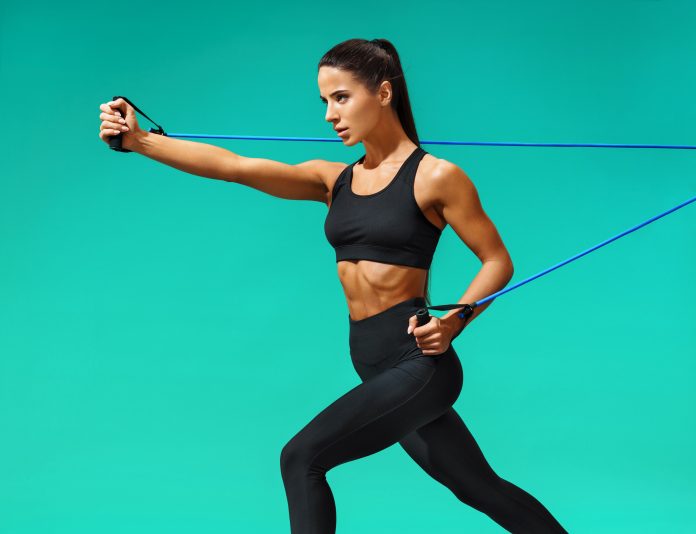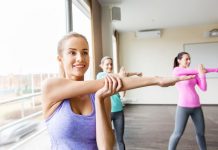If you’re just starting an exercise routine for the first time, you’re probably feeling a mix of emotions. It’s always exciting to try something new, but it can also be equal parts confusing and daunting. But the thing is, when it comes to working out, the best place to start really is at the beginning, with simple and effective exercises that’ll let you build a sturdy base you can use as a jumping off point as you get stronger and stronger.
Trust me, I know it can be tempting to try and tackle a workout that you found online that seems challenging, or a circuit that your favorite trainer posted on Instagram. But if you’re new to this whole exercise thing (welcome!), it really is absolutely essential that you start with the basics. And by the basics I mean classic exercises that let you practice the foundational movements upon which hundreds of other exercises are created. Most of these movement patterns are also functional, meaning they’re movements you do in everyday life, not just in the gym.
For example, the hip-hinge movement is one important movement pattern. It’s the motion of bending forward from your hips (not your back), and pushing your butt behind you. You do this movement in a squat (and almost every squat variation) and any type of deadlift. Learning how to properly do the basic versions of these exercises is key if you want to safely build on them as you get stronger. If you skip over mastering basic exercises that teach you to do foundational movements properly, you’ll be doing yourself (and your fitness goals) a disservice long term.
1. Squat
A squat is a classic exercise that shows up in tons of workouts. Learning a basic bodyweight squat will help you master the hip-hinge movement. It’s a compound exercise, meaning it works more than one muscle group at once, including the glutes, quads, and core.
- Stand with your feet slightly wider than hip-width apart, toes slightly turned out, arms at your sides, palms in.
- Engage your core and keep your chest lifted and back flat as you shift your weight into your heels, push your hips back, and bend your knees to lower into a squat. Bend your elbows and bring your palms together in front of your chest. (You can also just hold your hands in front of your chest the entire time.)
- Drive through your heels to stand and squeeze your glutes at the top for 1 rep.
2. Romanian Deadlift
The deadlift also trains the hip-hinge motion, but targets your hamstrings more than a squat does. It also works the glutes and core. You probably have usually seen deadlifts done with weights, but they can absolutely be done without them, Crockford says.
- Stand with your feet hip-width apart, knees slightly bent, arms relaxed by the front of your quads. This is the starting position.
- Hinge forward at your hips and bend your knees slightly as you push your butt way back. Keep your back flat and shoulders engaged as you slowly lower your arms along your shins toward the floor until you feel a stretch in your hamstrings.
- Keeping your core tight, push through your heels to stand up straight and return to the starting position. Keep your arms close to your shins as you pull. Pause at the top and squeeze your butt. That’s 1 rep.
3. Reverse Lunge
When you lunge, you’re training your body’s ability to do single-leg movements. Any lunge that has you transitioning from two feet to one foot and back again—like a forward lunge, reverse lunge, transverse lunge, or lateral lunge—fits the bill, says Crockford. By changing your base of support with each rep, you’ll train your balance and stability more than doing exercises where your base of support stays firmly on both feet. You’re also working your glutes, quads, and core.
I chose a reverse lunge here because they are typically easier on the knees and easier to control than forward lunges. But if you feel more comfortable lunging forward and don’t have any knee pain when you do, feel free to do that instead.
- Stand with your feet together with your arms by your sides (or pictured) or hands on your hips. This is the starting position.
- Step back (about 2 feet) with your right foot, landing on the ball of your foot and keeping your heel off the floor.
- Bend both knees until your left quad and right shin are parallel to the floor, your torso leaning slightly forward so your back is flat. Your left knee should be above your left foot and your butt and core should be engaged.
- Push through the heel of your left foot to return to the starting position. This is 1 rep.
- You can either alternate legs each time, or do all your reps on one side before switching to the other side.
4. Bent-over row
A row works the “pulling” movement pattern and specifically targets the muscles in the upper back. Unlike the other exercises here, you can’t really do a pull exercise without some sort of equipment, whether it’s dumbbells or a resistance band. Crockford recommends starting with a very light resistance band (you can simply stand on the other end) and thinking about keeping your shoulder blades back and down as you perform the rowing movement—your shoulders shouldn’t be rounded forward or hunched up tensely by your ears.
- Stand with your feet hip-width apart, holding a weight in each hand with your arms at your sides.
- With your core engaged, hinge forward at the hips, push your butt back, and bend your knees slightly, so that your back is no lower than parallel to the floor. (Depending on your hamstring flexibility, you may not be able to bend so far over.) Gaze at the ground a few inches in front of your feet to keep your neck in a comfortable position.
- Do a row by pulling the weights up toward your chest, keeping your elbows hugged close to your body, and squeezing your shoulder blades for two seconds at the top of the movement. Your elbows should go past your back as you bring the weight toward your chest
- Slowly lower the weights by extending your arms toward the floor. This is 1 rep.
Crockford says that the pull motion can be challenging to learn because it’s hard for many people to know what correctly stabilizing the scapula (shoulder blade) feels like. “What I always recommend for people to do first is lie on their backs and extend their arms above them like they’re reaching for the ceiling. Then, squeeze the shoulder blades together and actually feel the shoulder blades press into the ground.” Do a few reps of this, keeping your arms straight and only squeezing and releasing your shoulder blades. You can also do it with your back against the wall, Crockford says. The goal is to just get familiar with that motion of locking the shoulder blades in that position so that when you do the rowing movement, you will just bend your elbows and won’t be tempted to round forward and overextend your shoulders.
5. Plank
A plank is a great exercise for working on total-body stability as it engages your entire core, plus your shoulders and upper back. Crockford notes that it also helps you get in the right position for a push-up (more on that next). She recommends doing a high plank, with your arms straight and palms flat on the floor, as this will help you get used to engaging your upper back and pulling your shoulder blades back and in a stable position.






























